With ‘organ transplant,’ two churches find a home for a beloved instrument – September 23, 2018

Organ builder, Otto Pebworth tunes the organ at Calvary Presbyterian before the organ dedication service celebrating the recently installed pipe organ that was donated by Arlington Presbyterian after that church was demolished to make way for affordable housing, Sept. 23, 2018. (photo by Dayna Smith for the Washington Post)
WASHINGTON POST
By Martine Powers
Reporter covering the Metro transit system and transportation issues
September 23, 2018
https://wapo.st/2OLGtS7?tid=ss_mail&utm_term=.efa069a9e9c9
As the first sonorous notes burst from the pipe organ at Calvary Presbyterian Church on Sunday morning, it was easy to imagine the sound had boomed inside the Alexandria, Va., church since the building was erected in the 1950s.
But the organ and its more than 800 pipes were not original to the church. The instrument was brought to Alexandria from Arlington Presbyterian Church in an “organ transplant,” a pun that has provided no shortage of chuckles to congregants over the past few years.
On Sunday, the decades-old instrument made its official debut after an almost 2½-year process to get it transported and installed.
“The organ fills every single molecule of your body with this sound,” said Jan Lipscomb, grinning from the pews. “It’s incredible.”
The Rev. M. Michelle Fincher, Calvary’s pastor, said, “We have anticipated this day for what seems like a very long time.” Then Fincher turned to the parishioners from Arlington Presbyterian who stood scattered throughout the pews.
“And we are so grateful and so blessed by your generosity,” Fincher said.
The story of the “organ transplant” begins at Arlington Presbyterian, where church elders made a surprising decision three years ago to sell the church’s building, parking lot and grounds to a nonprofit organization that would use the land along Columbia Pike to build 173 units of affordable housing. The church’s congregation had dwindled to half its size from the early 2000s, and its leaders hoped their sacrifice would help alleviate, even slightly, the region’s increasingly dire housing crisis among the working class.

Gabriel Mayeden and Patience Ayenu provide the percussion during a rousing song during Calvary Presbyterian’s organ dedication service. (photo by Dayna Smith for the Washington Post)
The decision came with a quandary: If the building was razed, what would happen to the church’s beloved pipe organ?
That’s when Jane Kerr caught word that the organ’s stewards were seeking an adoptive home. At the time, Kerr had just begun her role as resident organist at Calvary Presbyterian, getting accustomed to finessing the church’s 40-year-old electronic organ each Sunday morning. (An electronic organ, when compared to a full-sized pipe organ, is like the sound of an electric keyboard contrasted with that of a grand piano.)
Calvary Presbyterian’s modest instrument had begun to experience what an engineer termed “metal fatigue,” and Kerr had noticed that it was starting to reach the end of its life.
“You’d play a note and it’s not quite there,” Kerr said. “We knew we had an organ that was in bad, bad shape, and we didn’t have big bucks for a whole new organ.”
Kerr is the kind of person who recognizes a sign from the divine when she encounters one: She played organ when she was younger but hadn’t played for
30 years — until the church announced that its organist was retiring and, as Kerr put it, “it felt like God was tapping me on the shoulder saying, ‘Get busy.’ ”
That’s the same feeling she had when she heard the Arlington congregation was seeking a home for its organ. After Kerr shared news with her church, Franklin Miller, Calvary’s clerk of session, wrote Arlington Presbyterian a letter that explained the significance of such a donation.
“Music is central to the worship of God, and music is an important part of our services here,” Miller recalled writing. Sunday’s service, for example, featured a choir, a violin, a cello, three brass instruments, a guitar, a harmonica, drums and a Nigerian percussion instrument known as a shekere. The organ, he urged, was central to the diverse mix of musical voices.
Most importantly, the organ could fit — if you played a game of Tetris. They’d measured the balcony at Calvary, and by ripping out all the pews, they believed they could fit the hundreds of pipes, which range from 11-foot-tall wooden columns to small metal pipes the size of a ballpoint pen.
Arlington Presbyterian said yes. Calvary Presbyterian was delighted. Now, all they had to do was transport the instrument and get it installed in the balcony.
That process ended up taking 2½ years.
On a hot summer day in 2016, they moved the hundreds of pipes, estimated to weigh more than 6,000 pounds in total, from Arlington to Alexandria, storing the pieces in an upstairs room.
Then, the church had to receive a top-to-bottom revamp. Architect Donald Lipscomb
busted out the 1950s blueprints of the church building. There were electrical upgrades. A new ventilation and speaker system were installed and camouflaged underneath new oak paneling behind the altar.

The pipes occupy the balcony of Calvary Presbyterian which held an organ dedication service celebrating the recently installed pipe organ which was donated by Arlington Presbyterian. (photo by Dayna Smith for the Washington Post)
There was also the balcony. After the pews were removed and the slanted balcony floor was leveled, there were rounds of engineering assessments, county site visits and building permits to ensure that the aerial structure was sturdy enough to hold three tons of weight.
Over the summer, there was a pipe washing party, where dozens of parishioners showed up to wash off 40 years of dust caked onto the organ pipes.
Finally, there was the tuning of the organ. Organ builders Otto Pebworth and Ralph Spoettle were at the church through Saturday evening to make sure the instrument was playing to perfection in time for Sunday morning’s service.
On Sunday morning, parishioners crowded into pews, and the organ released the opening chords of “Old Hundredth,” a classical hymn played often on the organ in Westminster Abbey.
“For this organ that will sound forth in beauty and glory, humbling our hearts before your eternal mysteries and lifting out souls to abiding joy,” called Fincher.
The churchgoers chanted back: “We praise you, oh God.”
“And as we dedicate this organ,” Fincher continued, “that it may kindle the flame of devotion, comfort the sorrowful, cheer the fainthearted, bring peace to our hearts and lead all who hear it in the way of eternal life.”
For Kerr, the organist, the feeling of playing the hymn’s swelling opening notes had already fulfilled all her hopes of how the new organ might inspire passion and comfort for her, and for her fellow churchgoers.
“It’s just a joy,” Kerr said. “From the tiniest, softest whispers to the grandest of all sounds, it’s all there. It’s a thrill.”
